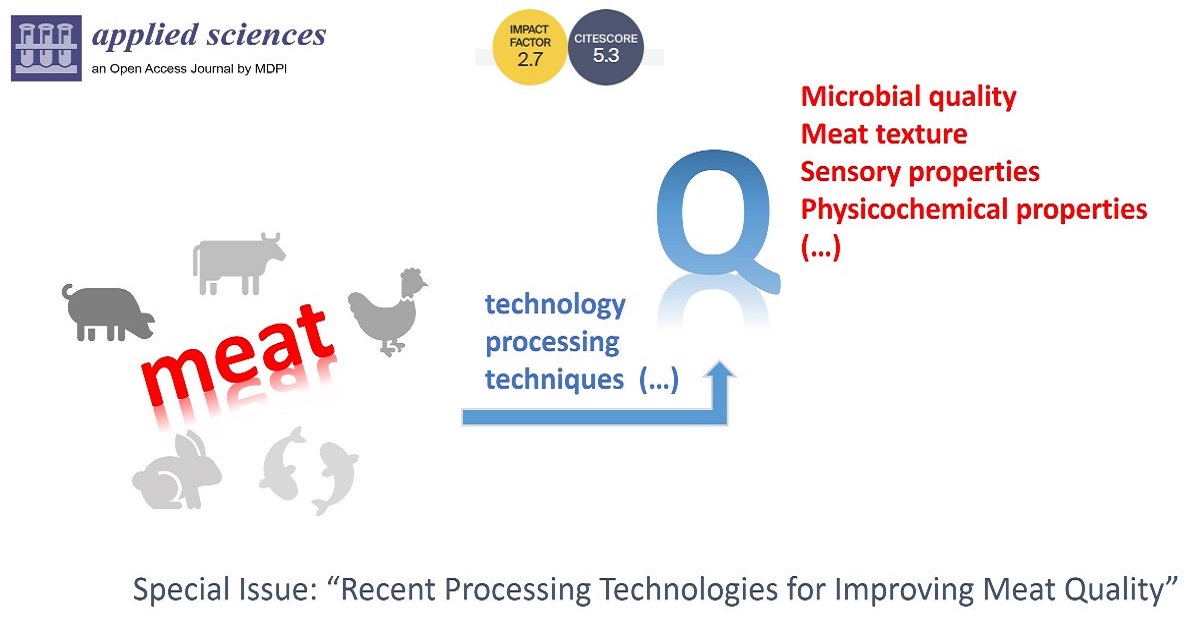Recent Processing Technologies for Improving Meat Quality
A special issue of Applied Sciences (ISSN 2076-3417). This special issue belongs to the section "Food Science and Technology".
Deadline for manuscript submissions: closed (20 February 2025) | Viewed by 11326

Special Issue Editors
Interests: meat quality; meat color; beef quality; meat marinating
Interests: meat; beef; functional meat products; cooking; composition
Special Issues, Collections and Topics in MDPI journals
Special Issue Information
Dear Colleagues,
Meat producers worldwide are challenged to provide nutritious and safe meat that appeals to consumers’ sensory, ecological and ethical considerations. Therefore, producers, processors, and scientists are seeking to improve the broadly understood quality of meat. This issue is essential due to the current trends in meat consumption, where high and repeatable quality (nutritional value, sensory, hygienic quality) and environmental aspects take priority over price. Therefore, it is crucial to implement different strategies and technological processes to improve the quality of meat in the context of both consumer preferences and sustainable production.
This Special Issue, “Recent Processing Technologies for Improving Meat Quality”, aims to present recent findings on technological factors that affect the final quality of meat, both in the sphere of production system and post-slaughter processing, i.e., ageing, packaging, cooking methods, etc.
Dr. Katarzyna Tkacz
Dr. Monika Modzelewska-Kapituła
Guest Editors
Manuscript Submission Information
Manuscripts should be submitted online at www.mdpi.com by registering and logging in to this website. Once you are registered, click here to go to the submission form. Manuscripts can be submitted until the deadline. All submissions that pass pre-check are peer-reviewed. Accepted papers will be published continuously in the journal (as soon as accepted) and will be listed together on the special issue website. Research articles, review articles as well as short communications are invited. For planned papers, a title and short abstract (about 100 words) can be sent to the Editorial Office for announcement on this website.
Submitted manuscripts should not have been published previously, nor be under consideration for publication elsewhere (except conference proceedings papers). All manuscripts are thoroughly refereed through a single-blind peer-review process. A guide for authors and other relevant information for submission of manuscripts is available on the Instructions for Authors page. Applied Sciences is an international peer-reviewed open access semimonthly journal published by MDPI.
Please visit the Instructions for Authors page before submitting a manuscript. The Article Processing Charge (APC) for publication in this open access journal is 2400 CHF (Swiss Francs). Submitted papers should be well formatted and use good English. Authors may use MDPI's English editing service prior to publication or during author revisions.
Keywords
- ageing
- cooking
- meat quality
- microbial quality
- technological processes
- meat texture
- sensory properties
- storage
- shelf-life
- packaging
- physicochemical properties
- thermal treatment
Benefits of Publishing in a Special Issue
- Ease of navigation: Grouping papers by topic helps scholars navigate broad scope journals more efficiently.
- Greater discoverability: Special Issues support the reach and impact of scientific research. Articles in Special Issues are more discoverable and cited more frequently.
- Expansion of research network: Special Issues facilitate connections among authors, fostering scientific collaborations.
- External promotion: Articles in Special Issues are often promoted through the journal's social media, increasing their visibility.
- e-Book format: Special Issues with more than 10 articles can be published as dedicated e-books, ensuring wide and rapid dissemination.
Further information on MDPI's Special Issue policies can be found here.






